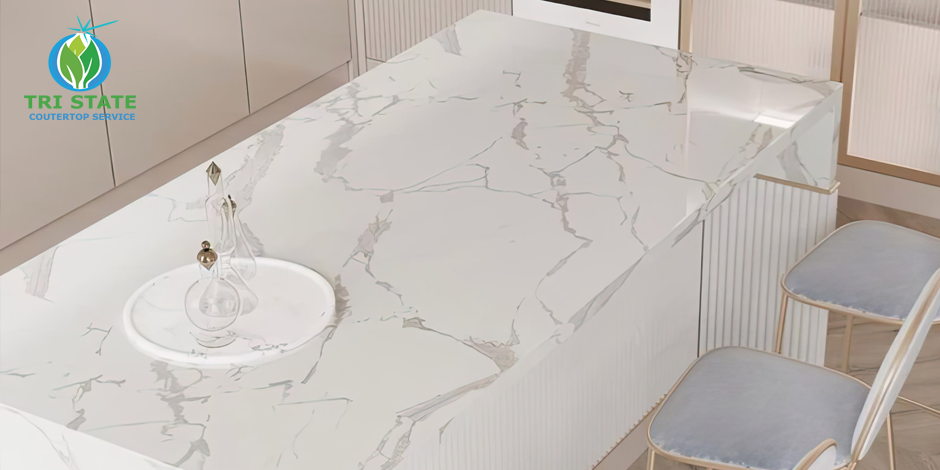
How to Safely Remove Acidic Stains from Marble Countertops
Marble countertops, which are frequently found in kitchens and bathrooms, are a representation of sophistication and elegance. However, they are vulnerable to damage due to their porous and delicate nature, particularly from acidic stains from spills like coffee, wine, vinegar, or lemon juice. If not treated properly, these stains have the potential to etch or dull the surface, reducing the marble’s inherent beauty. Your countertops will stay immaculate thanks to Tri State Marble Countertop Care‘s expertise in marble repair and maintenance in the Radnor Area of Pennsylvania. To properly remove acidic stains from marble countertops, follow these steps.
Understanding Acidic Stains on Marble
Calcium carbonate, which makes up marble, reacts with acidic materials. Marble is eroded by acids, which result in dull patches or “etch marks” on the surface. These marks can occasionally feel harsh to the touch and frequently show up as hazy patches. In order to resolve these problems without doing more damage, proper cleaning and maintenance are crucial.
What You’ll Need for Safe Stain Removal
To guarantee safe and efficient stain removal, acquire the following supplies before beginning:
- Soft microfiber cloths or sponges
- Warm water
- pH-neutral marble cleaner (available in stores or online)
- Baking soda
- Distilled water
- Plastic wrap
- Masking tape
- A soft-bristled brush
- Marble polishing powder (if needed)
Step-by-Step Guide to Removing Acidic Stains from Marble Countertops
Step 1: Blot the Stain Immediately
Blot the area gently with a soft microfiber cloth if the acid spill is recent. Rubbing can spread the substance and exacerbate the harm, so avoid doing so. Blotting aids in absorbing the acid before it has a chance to further etch the marble surface.
Step 2: Clean the Area with Warm Water and Marble Cleaner
Combine a pH-neutral marble cleanser with warm water. Wipe the stained area gently with a damp microfiber cloth. Make sure the cleaner you’re using is safe for marble because harsh chemicals can make the etching worse. By removing surface impurities, this stage gets the marble ready for more extensive treatment.
Step 3: Create a Baking Soda Poultice
Regarding enduring acidic stains:
- Create a thick paste by combining baking soda and distilled water.
- Liberally cover the stained area with the paste.
- Use plastic wrap to cover the paste, then use masking tape to seal the edges.
- To allow the poultice to extract the stain, let it sit for 24 to 48 hours.
Use a gentle cloth to carefully remove the poultice once it has dried, and then rinse the area with distilled water.
Step 4: Buff the Surface with a Soft-Bristled Brush
For light etching, lightly buff the area in circular motions with a soft-bristled brush. By doing this, the marble’s flawless surface is restored. Refrain from exerting excessive pressure since this may exacerbate the harm.
Step 5: Apply Marble Polishing Powder (If Necessary)
Use marble polishing powder for etch marks that are deeper. Apply a tiny bit to the afflicted region, then use a damp microfiber cloth or a low-speed polisher to gently buff it. Follow the manufacturer’s guidelines to avoid over-polishing, which could lead to uneven results.
Step 6: Seal the Marble Countertop
Once the stain has been cleaned and the surface recovered, use a high-quality marble sealer to safeguard the countertop. Sealing creates a barrier against future spills and prolongs the life of your marble surface.
Preventing Acidic Stains on Marble Countertops
It’s always better to prevent than to treat. To reduce the possibility of acidic stains, heed these suggestions:
- Use Coasters and Trays: Put coasters beneath bottles and glasses, particularly those that contain acidic liquids like wine or citrus drinks.
- Clean Spills Immediately: Use a gentle cloth and warm water to clean up accidents as soon as possible.
- Avoid Harsh Cleaners: Only use pH-neutral cleaners made especially for marble.
- Use Cutting Boards: Keep acidic foods away from your marble worktops.
- Regular Sealing: To keep a protective layer in place, reapply marble sealant on a regular basis.

When to Call Professionals
Etching and acidic stains can occasionally be too severe to treat with do-it-yourself techniques. Professional intervention is crucial in these situations. Tri State Marble Countertop Care provides professional services, such as marble countertop crack restoration, stain removal, and edge repair, to return your marble countertops to their former splendor:
- Marble Countertop Crack Restoration
- Stain Removal
- Edge Repair
- Polishing and Sealing
Using cutting-edge methods and equipment, our staff is adept at repairing all kinds of marble damage, guaranteeing consistently excellent outcomes.
Why Choose Tri State Marble Countertop Care?
- Experienced Professionals: Years of experience in maintaining and restoring marble.
- State-of-the-Art Techniques: For efficient stain removal and etching correction, we employ the newest equipment and supplies.
- Comprehensive Services: We handle everything, from small fixes to total restoration.
- Customer-Centric Approach: Solutions that are specifically designed to satisfy the demands of our Radnor Area clients.
Get in Touch with Us
Let Tri State Marble Countertop Care‘s professionals take care of any damage or acidic stains on your marble countertop. Our goal is to maintain the beauty and usefulness of your marble surfaces by offering top-notch services.
- Call Us: (+1) 215-840-1440
- Email Us: info@tristatemarblepolishing.co
- Service Area: Radnor Area, Pennsylvania
Don’t wait for the damage to worsen—reach out immediately to book a consultation or learn more about our services. Let us help you protect your investment and keep your marble countertops looking magnificent for years to come.
With the correct maintenance and professional guidance, acidic stains don’t have to mean disaster for your marble countertops. Follow this advice to manage small stains and call the experts at Tri State Marble Countertop Care for more severe restoration needs.

0 comments